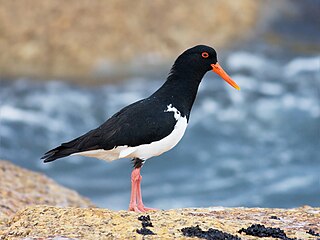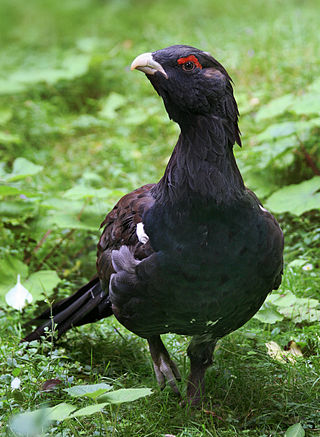
Spoonbills are a genus, Platalea, of large, long-legged wading birds. The spoonbills have a global distribution, being found on every continent except Antarctica. The genus name Platalea derives from Ancient Greek and means "broad", referring to the distinctive shape of the bill. Six species are recognised, which although usually placed in a single genus have sometimes been split into three genera.

Bustards, including floricans and korhaans, are large, terrestrial birds living mainly in dry grassland areas and on the steppes of the Old World. They range in length from 40 to 150 cm. They make up the family Otididae.

The oystercatchers are a group of waders forming the family Haematopodidae, which has a single genus, Haematopus. They are found on coasts worldwide apart from the polar regions and some tropical regions of Africa and South East Asia. The exceptions to this are the Eurasian oystercatcher, the South Island oystercatcher, and the Magellanic oystercatcher, which also breed inland, far inland in some cases. In the past there has been a great deal of confusion as to the species limits, with discrete populations of all black oystercatchers being afforded specific status but pied oystercatchers being considered one single species.

The common shelduck is a waterfowl species of the shelduck genus, Tadorna. It is widespread and common in the Euro-Siberian region of the Palearctic, mainly breeding in temperate and wintering in subtropical regions; in winter, it can also be found in the Maghreb.

The common redshank or simply redshank is a Eurasian wader in the large family Scolopacidae.

The avian genus Quiscalus contains seven of the 11 species of grackles, gregarious passerine birds in the icterid family. They are native to North and South America.

Tringa is a genus of waders, containing the shanks and tattlers. The genus name Tringa is the Neo-Latin name given to the green sandpiper by the Italian naturalist Ulisse Aldrovandi in 1599. They are mainly freshwater birds, often with brightly coloured legs as reflected in the English names of six species, as well as the specific names of two of these and the green sandpiper. They are typically associated with northern hemisphere temperate regions for breeding. Some of this group—notably the green sandpiper—nest in trees, using the old nests of other birds, usually thrushes.

The greater yellowlegs is a large shorebird in the family Scolopacidae. It breeds in central Canada and southern Alaska and winters in southern North America, Central America, the West Indies and South America.

The lesser yellowlegs is a medium-sized shorebird. It breeds in the boreal forest region of North America.

The Eurasian stone-curlew, Eurasian thick-knee, or simply stone-curlew is a northern species of the Burhinidae (stone-curlew) bird family.

The Eurasian scops owl, also known as the European scops owl or just scops owl, is a small owl in the typical owl family Strigidae. Its breeding range extends from southern Europe eastwards to southern Siberia and the western Himalayas. It is migratory, wintering in Africa south of the Sahara.

Charadrius is a genus of plovers, a group of wading birds. The genus name Charadrius is a Late Latin word for a yellowish bird mentioned in the fourth-century Vulgate. They are found throughout the world.

The anis are the three species of birds in the genus Crotophaga of the cuckoo family. They are essentially tropical New World birds, although the range of two species just reaches the United States.

Ardea is a genus of herons. These herons are generally large in size, typically 80–100 cm or more in length.

The genus Paradisaea consists of six species of birds-of-paradise. The genus is found on the island of New Guinea as well as the nearby islands groups of the Aru Islands, D'Entrecasteaux Islands and Raja Ampat Islands. The species inhabit a range of forest types from sea level to mid-montane forests. Several species have highly restricted distributions, and all species have disjunct distributions. A 2009 study examining the mitochondrial DNA of the family found that the Paradisaea birds-of-paradise were in a clade with the genus Cicinnurus. It showed that the blue bird-of-paradise was a sister taxon to all the other species in this genus.

Tetrao is a genus of birds in the grouse subfamily known as capercaillies. They are some of the largest living grouse. Feathers from the bird were used to create the characteristic hat of the bersaglieri, an Italian ace infantry formation.

The streamertails are hummingbirds in the genus Trochilus, that are endemic to Jamaica. It is the type genus of the family Trochilidae. Today most authorities consider the two taxa in this genus as separate species, but some continue to treat them as conspecific, in which case scitulus is a subspecies of T. polytmus. A wide range of common names apply to this combined species, including green-and-black streamertail, Jamaican streamertail or simply streamertail. The name streamertail is a reference to the greatly elongated rectrices of the males.

The Arabian bustard is a species of bustard which is found across the Sahel region of Africa and south western Arabia. It is part of the large-bodied genus, Ardeotis, and, though little known, appears to be a fairly typical species in that group.

Parus is a genus of Old World birds in the tit family. It was formerly a large genus containing most of the 50 odd species in the family Paridae. The genus was split into several resurrected genera following the publication of a detailed molecular phylogenetic analysis in 2013. The genus name, Parus, is the Latin word for "tit".

The great bustard is a bird in the bustard family, and it is the only living member of the genus Otis. It breeds in open grasslands and farmland from northern Morocco, South and Central Europe, to temperate Central and East Asia. European populations are mainly resident, but Asian populations migrate farther south in winter. It has been listed as a Vulnerable species on the IUCN Red List since 1996.






















